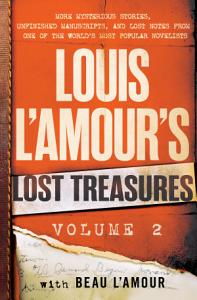Book Review: Louis L’Amour’s Lost Treasures Volume 2 by Louis L’Amour with editorial material by Beau L’Amour
Disclaimer: I received an Advance Uncorrected Proof of this book through a Goodreads giveaway to facilitate the writing of this review. No other compensation was requested or offered. As an uncorrected proof, there will be changes made in the final product.
Louis L’Amour (1908-1988) was one of the all-time great Western authors, and most of his published work is still in print one way or another, mostly in authorized editions. Writing constantly from the 1930s to the 1980s, his output was prolific. But not everything he touched got completed. Many pieces were left half-done, or weren’t quite right, or were done on speculation for movie producers. This volume contains a number of these unfinished works.

As explained in Beau L’Amour’s introduction, his father had never meant to be exclusively a writer of Westerns, and wrote many other kinds of adventure stories. It just so happened that when the pulp market dried up in the late 1940s, L’Amour wanted to move into the paperback novel field, and Westerns were both something he did very well and were in demand. And it did not hurt that John Wayne starred in a movie, Hondo, based on one of L’Amour’s stories, which the writer then turned into a full novel based on the movie.
Once successfully established as a Western novel writer, Louis L’Amour began pushing the boundaries of what his publishers would accept, moving the Sackett family saga back to colonial days, as well as trying historical fiction set in other parts of the world, and even science fiction.
The selections in this book begin with “The Bastard of Brignogan”, a historical novel about the adventures of a French ninja in India who would be the progenitor of the Talon family. It looks like it would have been a jam-packed novel full of twists and turns, but at least one of the reasons it only ever got started was trying to figure out how Talon got his ninja training.
The final piece is “Borden Chantry II”, a mystery novel starring Borden Chantry as he deals with a mysterious corpse on his land and a suspicion that not all is right in the town he’s the marshal for. Presumably it would have had a better title if finished–this was apparently one of the stories Mr. L’Amour was working on in his final days. The mystery aspect is spoiled a bit by suddenly switching to the bad guys’ perspective, but the writing gets more confident at the same time.
The biggest chunk of this book is seventeen! chapters of “Ben Mallory”, an adventure novel set in Chinese-occupied Tibet. The title character is on a journey with the isolated tribe of warriors who have adopted him to get out of the country so they can get weapons to keep the Red Chinese off their territory. Along the way, they run into both an American scientific expedition and a lama who is being sought by the Chinese army to become a puppet for the Communist regime.
This long fragment shows off L’Amour’s research skills and lets him stretch his more mystical side as a writer. (Does reincarnation truly exist? Is the yeti real or is it just a scarily competent human mountain dweller? How does that one man manage to keep getting ahead of Mallory without leaving tracks?)
There’s a bit of “mighty whitey” in the way Mallory is set up. (That’s when a white Westerner comes to a foreign land and is better at what the natives do than the natives are plus having the advantages of Western education/civilization.) To temper this a bit, one of Mallory’s foils is Gunther Hart, who thinks he’s a mighty whitey, but in fact is just ridiculously wealthy so everything he wanted was just handed to him.
This one might have been a blockbuster back in the day, but would be difficult to get published now.
Also of note: “The Jade Eaters”, an SFnal movie treatment set in Mexico that went far enough that Universal still owns the rights (but allowed to be published here) and “The Freeze”, the beginning of a short story set during a new Ice Age.
I like the typography; the manuscripts are presented in an old-fashioned manual typewriter font, while the editorial comments by Beau are in a more standard modern typeface. All the stories have such comments about the background of the manuscripts and tales from L’Amour’s life, and there are a number of black and white photographs throughout.
Because of the unfinished nature of most of the pieces, I was often frustrated by cut-offs just when the story was “getting good.” I would not recommend this (or Lost Treasures Volume 1) as anyone’s first Louis L’Amour book. This volume is strictly for seasoned fans who can appreciate the might-have-beens.
Instead, newer fans might want to check out the new “Lost Treasures” editions of some of L’Amour’s finished books like Last of the Breed and How the West Was Won which have additional editorial notes, short stories that the novels were expanded from, and other fan-aimed material.
But if you’re a seasoned fan looking for fanfic ideas or just some more good Louis L’Amour writing, this one’s a keeper.
Let’s hear from the man himself!

